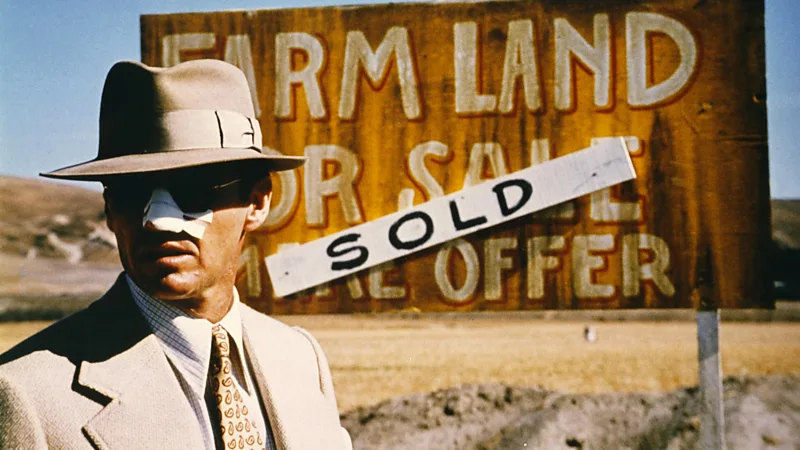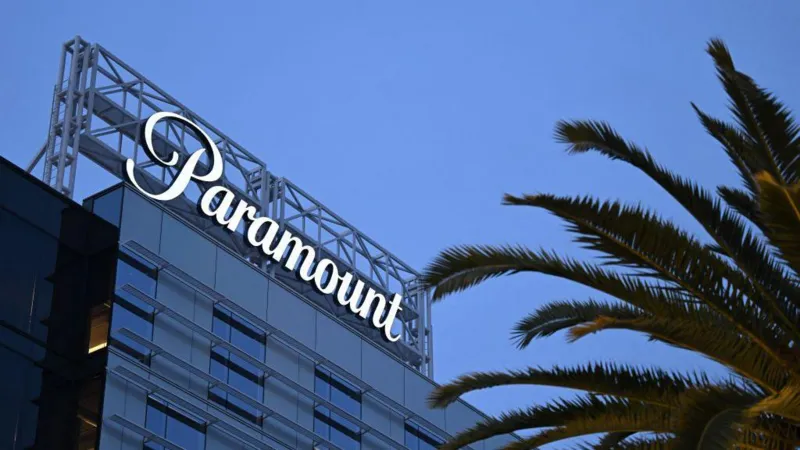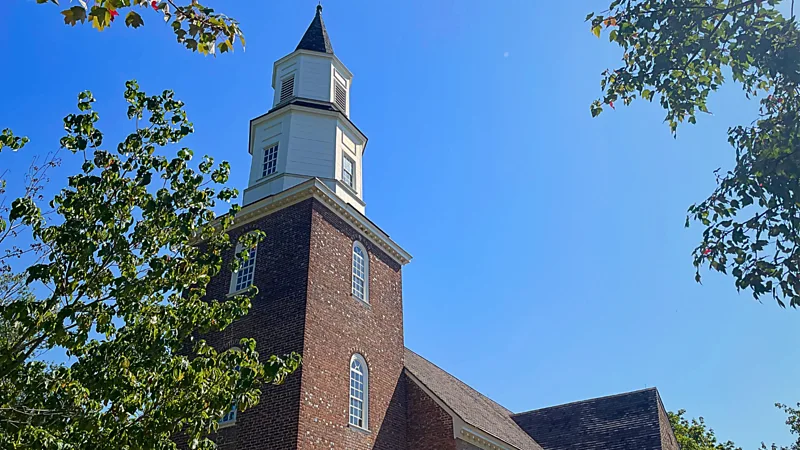Chinatown: The real-life California scandal that inspired the iconic Los Angeles thriller
Now 50 years old, Chinatown is one of the all-time great crime films – and that's partly because of a potent story based on the real history of California's so-called "water wars".

"Forget it Jake, it's Chinatown…" is one of the most famous lines in film history. The dialogue closes a lynchpin of post-war US cinema: Roman Polanski's Chinatown (1974). The 1930s-set neo-noir, which turned 50 this week, is still a regular talking point in popular culture, for everything from its celebrated screenplay by Robert Towne (for which it won its sole Oscar) to its phenomenal score by Jerry Goldsmith, its astonishing lead performances by Jack Nicholson, Faye Dunaway and John Huston, to the subsequent disgrace of its criminally convicted, fugitive director.
Polanski and Towne's story was part of a particular trend in crime cinema of the period. While Watergate-inflected thrillers like Francis Ford Coppola's The Conversation (1974) and Alan J Pakula's The Parallax View (1972), and hyper-aggressive cop flicks like Don Siegel's Dirty Harry (1971) and William Friedkin's The French Connection (1971), were all caught up in present day issues, a new alternative to gritty procedurals and paranoid political thrillers was becoming popular – namely the lavish period crime film.
Arguably peaking with Coppola's The Godfather (1972) and The Godfather Part II (1974), the movement was really kickstarted by the success of Arthur Penn's Bonnie and Clyde (1967), and also resulted in the likes of Dick Richards' Farewell, My Lovely (1975), Bernardo Bertolucci's The Conformist (1970) and Jacques Deray's Borsalino (1970), to name a few. Essentially, these films denied the nostalgic draw of the past to instead explore its dark underbelly – and like a number of them, Chinatown expressed this resistance by actually building on real history.
The real history lent itself to Chandler-esque noir plotting. The aqueduct project was a mystery to the public in its early stages, and money and power drove it – John Walton
The film looked back to the dirty dealings behind Los Angeles's transformation into a major urban centre, taking inspiration from the original California "water wars" that erupted at the turn of the 20th Century. These occurred when the Los Angeles water department bought up a swathe of land in east California in order to divert water to sate its growing population, to the detriment of the rural community it was taking supply away from. What's more, Chinatown borrows some aspects of the life of civil engineer William Mulholland, the controversial figure who was the first superintendent of the Los Angeles water system and tasked with creating the aqueduct to ensure the city had sufficient water supply; all this aided the film's sense of authenticity to the point where its dark fictions have influenced the perception of the city's real history.
Chinatown begins with a quintessential film noir set-up. In 1930s Los Angeles, private detective JJ Gittes (Nicholson) is hired by a woman who goes by the name of Evelyn Mulwray to prove her husband's infidelity. Believing it's a simple case, he investigates the woman's husband, Hollis (Darrell Zwerling), obtaining photo proof of him meeting a woman. However, things get complicated when these pictures of Hollis and his apparent mistress are splashed in the newspaper, and it turns out that the woman who hired him was only pretending to be Evelyn. The real Evelyn (Faye Dunaway) turns up at Gittes' office and threatens to sue him for the scandal.
Gittes learns that Hollis is a senior engineer at the Los Angeles Department of Water and Power, and Evelyn's father is Noah Cross (Huston) – the former co-owner of the department with Hollis, who is determined for the city's latest dam scheme to go ahead. From there, he is drawn into a world of corruption, violence and murder. Hollis soon turns up dead in a water reserve, and Evelyn is hiding an even darker secret that may just explain the violence that comes Gittes's way as he searches for the woman who he first saw Hollis meet (at both Evelyn's and Noah's separate and competing requests).
A journalistic story
When quizzed about his work in 2001, Towne suggested that he was initially drawn to journalism before screenwriting. "What I thought," he recalled, "was that I was going be a journalist. I've always thought screenwriting is very well served by knowledge of the world. And journalists do nothing so much as report stories… Their eye for telling detail is perfect for screenwriters."
Towne took a somewhat journalistic approach to Chinatown, drawing detail from real life but running with it into fictional realms. The history that the film looked back to specifically concerned the issue of the clean water-supply of Los Angeles as it grew in size during the early 1900s, although the film's narrative translates this to the 1930s. Meanwhile where the real-life "water wars" took place over water diverted from Owens Valley, east of the Sierra Nevada mountains, with an aqueduct built by Mulholland and team in 1913, the action in Chinatown concerns water in the San Fernando valley, an area much closer to LA, which was subsequently incorporated into the city limits.
But while it doesn't replicate the "water wars" exactly, the scheme at the centre of Chinatown still feels believable – and certainly expands on the exploitation. "The real history lent itself to Chandler-esque noir plotting," says Professor John Walton of UC Davis's Department of Sociology, who researched the real-life history of the "water wars" for his book Western Times and Water Wars: State, Culture and Rebellion in California. "The aqueduct was a plan fashioned by a small group of wealthy promoters; the project was a mystery to the public in its early stages; money and power drove it; the 'little guy' was in the dark about his or her exploitation; intrigue enveloped city-valley dealings."
Chinatown reflects how powerful figures in Los Angeles's fight to control natural resources led to the lives and livelihoods of ordinary people, including farmers, being destroyed.
In Chinatown, the water department, under the influence of Cross, is behind a plan to secretly dump water from a vital reservoir in the San Fernando valley at night during a drought, so that the local agricultural land becomes unusable, and is devalued – allowing the department and Cross to buy it off cheaply from those forced out. Gittes finds that the land is changing ownership to random names taken from the residents (some recently deceased) of a local retirement home to hide the insider investors' identity. Handily, too, Cross's desired new dam would solve the problem of the lack of water supply, ensuring a vast profit from the subsequent increase in value of the cheaply acquired land once properly supplied with water again.
When it came to the real-life water supply project, it quickly inspired disillusionment. "By the early 1920s any hope of shared benefits [from the Los Angeles water department buying up Owens Valley] evaporated with a drought and increased groundwater pumping to maintain the supply delivered by the aqueduct to the city," Walton tells the BBC. "Ranchers and small-town domestic users saw the local water table drop and their wells run dry." This was the situation that was foreseen by the project's opponents, leading to attempts to destroy it. "After many unsuccessful efforts to gain a share of the diminishing supply, local citizens staged a rebellion, initially by dynamiting the aqueduct and in 1924 occupying the Alabama Hills spill gates, which were opened, allowing the city's supply to flow on to the valley floor."
Clearly, Towne was more interested in using this history as a jumping-off point rather than offering up a dramatic exposé. "Towne's story is highly fictionalised," continues Walton, "reconstructed as a Raymond Chandler mystery for history that was no mystery. The central events of the aqueduct construction and water expropriation took place roughly from 1905 to 1924, not in 1937. They took place in the distant Owens Valley, not in the San Fernando Valley. [And] in the insurgency, later labelled a 'water war', no one was murdered or even seriously injured."
But for all these differences, Chinatown does reflect how powerful figures in Los Angeles's fight to control natural resources led to the lives and livelihoods of ordinary people, including farmers, being destroyed. When Gittes visits an orange grove affected by Cross's water dumping, he's given a far from warm welcome by the orange farmers, who think he is a water department agent, and beat him up as he attempts to escape. It's not inconceivable that the real Mulholland would have received an equally aggressive welcome in Owens Valley.
The man who was the biggest inspiration
As for Mulholland, though he was not alone in his endeavours, he's undeniably the single figure that most inspired aspects of Chinatown. Interestingly, however, he's not present in the film as one person. As author Vincent Brook writes in his book Land of Smoke and Mirrors (2013), Mulholland was split across characters to account for the different sides of the real man's legacy. "William Mulholland is split into noble Water and Power chief Hollis Mulwray… and mobster muscle Claude Mulvihill (Roy Jensen)." This reflects the fact that Mulholland did essential work to allow Los Angeles to survive and grow, and enabled this to be used for personal and corrupt gain.
Chinatown is misunderstood by many as the true history of the Los Angeles water wars – John Walton
Hollis Mulwray's name is another throwback to Mulholland, though the character is ironically the engineer most opposed to the film's water-supply scheme, objecting to the dam plan due to the instability of the ground in the area. This is what gets him murdered. His opposition echoes the real Mulholland only in that, sometime after the original "water wars", the engineer was involved in an actual dam disaster. In 1928, Mulholland inspected the St Francis Dam in San Francisquito Canyon only hours before its subsequent break, resulting in a flood that killed over 400 people. It more than finished Mulholland's career. The character of Hollis feels from a parallel world where Mulholland was given a second chance and has a newly found caution over potentially risky projects.
In some ways, the portrayal of Hollis, principled victim as he is, may have brightened Mulholland's subsequent reputation, such is the belief that Hollis is a fictional cipher. He was, however, certainly no angel, happily leading a water supply scheme that not only devastated the farmers of Owens Valley, but also enriched various business people through insider land deals equivalent to the ones in Chinatown. Indeed, Mulholland clearly shared some characteristics with Cross too – and on top of that Cross's style and look in the film was also closely inspired by photos of the real Mulholland, further muddying the water.
In fact, the machinations surrounding the city's water supply are, by the film's conclusion, moot. As it turns out, Cross's grab for resources has been dark symbolism for his most evil abuse of power – the rape of Evelyn, his own daughter, and the incestuous child born of it. In Morrow Mayo's 1933 history book Los Angeles, the chapter dealing with the real Owens Valley project was infamously called The Rape of Owens Valley. Though a controversial and contested characterisation since, it expresses a sentiment about the powerful's unchecked assault on human lives that is taken to its most horrifically literal ends with Chinatown's climactic narrative revelations.
Polanski and Towne's script may not have aimed for documentary recreation, but their borrowing and reshaping of real history allowed the work to stand out from its more fictional peers. So convincing is it in its detail that, Walton concludes, Chinatown is misunderstood by many "as the true history of the Los Angeles water wars, the popular culture understanding of what really happened". Fiction it may be, but Chinatown is one of the great noirs precisely because it authentically captures how politics and business can mix easily with crime and corruption, and how the striving for power of those at the top can leave many victims down below in the dust.
-bbc






